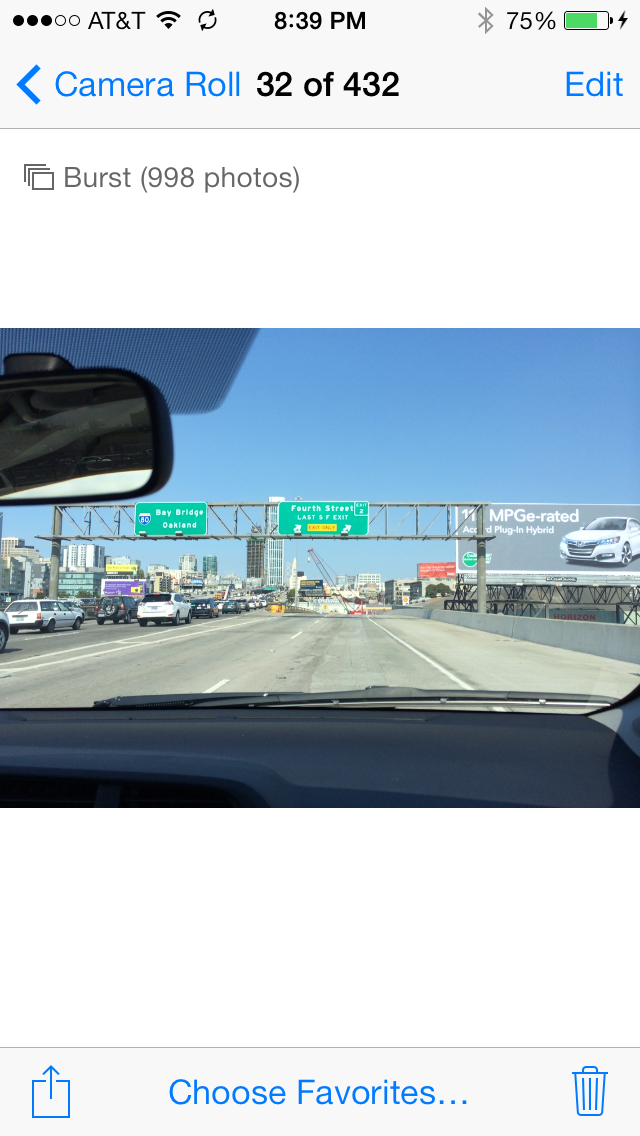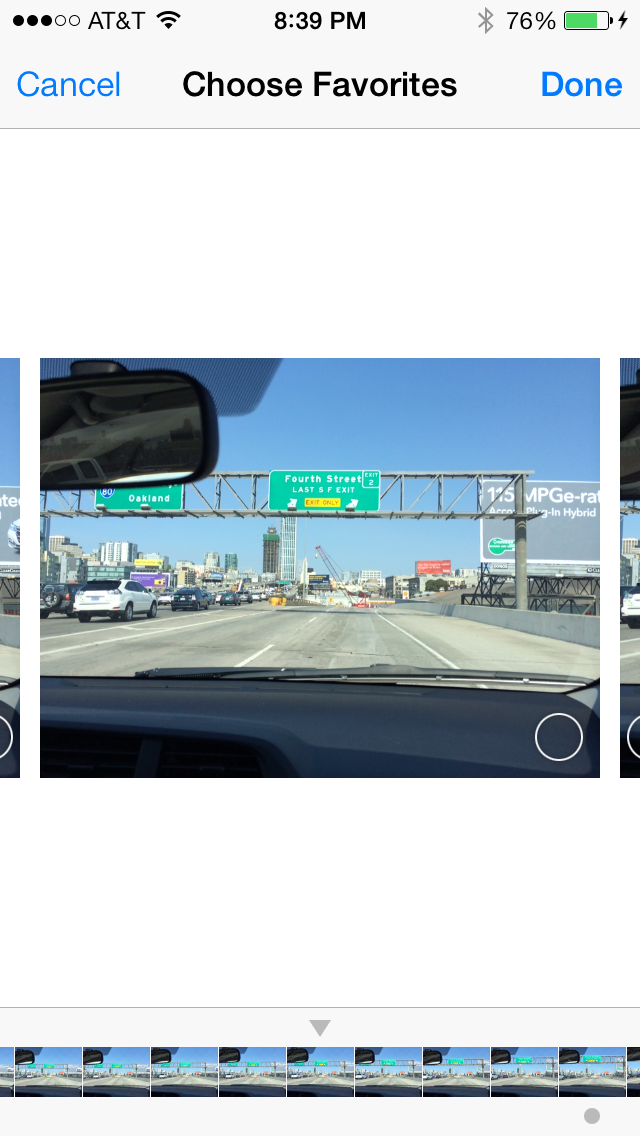The iPhone 5s Review
by Anand Lal Shimpi on September 17, 2013 9:01 PM EST- Posted in
- Smartphones
- Apple
- Mobile
- iPhone
- iPhone 5S
Camera
The iPhone 5s continues Apple’s tradition of sensible improvements to camera performance each generation. I was pleased to hear Phil Schiller deliver a line about how bigger pixels are a better route to improving image quality vs. throwing more at the problem. I remember hearing our own Brian Klug deliver almost that exact same message a year earlier when speaking to some engineers at another phone company.
The iPhone 5s increases sensor size compared to the iPhone 5. Last week Brian dug around and concluded that the 5s’ iSight camera sensor likely uses a format very similar to that of the HTC One. The difference here is while HTC opted for even larger pixels (arriving at 4MP), Apple chose a different balance of spatial resolution to light sensitivity with its 8MP sensor.
One thing ingrained in my mind from listening to Brian talk about optics is that there is no perfect solution, everything ultimately boils down to a selection of tradeoffs. Looking at Apple/HTC vs. the rest of the industry we see one set of tradeoffs, with Apple and HTC optimizing for low light performance while the rest of the industry chasing smaller pixel sizes. Even within Apple and HTC however there are differing tradeoffs. HTC went more extreme in pixel size while Apple opted for more spatial resolution.
| iPhone 4, 4S, 5, 5S Cameras | ||||
| Property | iPhone 4 | iPhone 4S | iPhone 5 | iPhone 5S |
| CMOS Sensor | OV5650 | IMX145 | IMX145-Derivative | ? |
| Sensor Format |
1/3.2" (4.54x3.42 mm) |
1/3.2" (4.54x3.42 mm) |
1/3.2" |
~1/3.0" (4.89x3.67 mm) |
| Optical Elements | 4 Plastic | 5 Plastic | 5 Plastic | 5 Plastic |
| Pixel Size | 1.75 µm | 1.4 µm | 1.4 µm | 1.5 µm |
| Focal Length | 3.85 mm | 4.28 mm | 4.10 mm | 4.12 mm |
| Aperture | F/2.8 | F/2.4 | F/2.4 | F/2.2 |
| Image Capture Size |
2592 x 1936 (5 MP) |
3264 x 2448 (8 MP) |
3264 x 2448 (8 MP) |
3264 x 2448 (8 MP) |
| Average File Size | ~2.03 MB (AVG) | ~2.77 MB (AVG) | ~2.3 MB (AVG) | 2.5 MB (AVG) |
Apple moved to 1.5µm pixels, up from 1.4µm in the iPhone 5. Remember that we’re measuring pixel size in a single dimension, so the overall increase in pixel size amounts to around 15%. Apple also moved to a faster aperture (F/2.2 vs. F/2.4 on the iPhone 5) to increase light throughput. The combination can result in significantly better photos than the outgoing 5 when taking photos in low light.
With the move to larger pixels, Apple has done away with its 2x2 binning mode in low light settings. The iPhone 5 would oversample each pixel after scene brightness dropped below a certain threshold to improve low light performance. The oversampled image would then be upscaled to the full 8MP, trading off spatial resolution for low light performance. The iPhone 5s doesn’t have to make this tradeoff. In practice I didn’t find any situations where the 5s’ low light performance suffered as a result. It always seemed to produce better shots than the iPhone 5.
Unlike some of the larger flagships we’ve reviewed lately, the iPhone 5s doesn’t ship with optical image stabilization (OIS). We’ve seen devices from HTC, LG and Nokia all ship with OIS, and have generally been pleased with the results. It’s not a surprise that the 5s doesn’t come with OIS as it’s largely the same physical platform as the outgoing 5. Still it would be great to see an Apple device ship with OIS. Perhaps on a larger iPhone.
As is always the case in space constrained camera systems, what Apple could not achieve in the physical space it hopes to make up for computationally. The 5s leverages electronic image stabilization as well as automatic combination of multiple frames from the capture buffer in order to deliver the sharpest shots each time.
Apple’s cameras have traditionally been quite good, not just based on sensor selection but looking at the entire stack from its own custom ISP (Image Signal Processor) and software. With the A7 Apple introduces a brand new ISP. Although we know very little about the new ISP, you can find references to Apple’s H6 ISP if you dig around.

Apple continues to ship one of the better auto modes among smartphone cameras I've used. I still want the option of full manual controls, but for most users Apple's default experience should be a very good one.
Capturing shots under iOS 7 is incredibly quick. Shot to shot latency is basically instantaneous now, thanks to a very fast ISP and the A7’s ability to quickly move data in and out of main memory. It’s impossible to write shots to NAND this quickly so Apple is likely buffering shots to DRAM before bursting them out to non-volatile storage.
The new ISP enables a burst capture mode of up to 10 fps. To active burst mode simply hold down the shutter button and fire away. The iPhone 5s will maintain a 10 fps capture rate until the burst counter hits 999 images (which was most definitely tested). Although it took a while to write all 999 images, all of them were eventually committed to NAND.
Photos captured in burst mode are intelligently combined as to not clutter your photo gallery. The camera app will automatically flag what it thinks are important photos, but you’re free to choose as many (or as few) as you’d like to include in your normal browsing view. Since all of the photos captured in burst mode are physically saved, regardless of whether or not you select them to appear among your photos, you can always just pull them off the 5s via USB.
The rear facing camera is paired with a new dual-LED True Tone flash. Rather than featuring a single white LED to act as a flash, Apple equips the iPhone 5s with two LEDs with different color tones (one with a cool tone and one with a warm tone). When set to fire, the 5s’ ISP and camera system will evaluate the color temperature of the scene, pre-fire the flash and determine the right combination of the two LEDs to produce the most natural illumination of the subject.
I’m not a huge fan of flashes, but I have to say that in a pinch the True Tone flash is appreciably better than the single LED unit on the iPhone 5. Taking photos of people with the new True Tone flash enabled produces much warmer and more natural looking results:
Even if your subject happens to be something other than a person I’ve seen really good results from Apple’s True Tone flash.
I still believe the best option is to grab your photo using natural/available light, but with a smartphone being as portable as it is that’s not always going to be an option.
I have to say I appreciate the vector along which Apple improved the camera experience with the iPhone 5s. Improving low light performance (and quality in low light situations where you’re forced to use a flash) is a great message to carry forward.
Front Facing Camera
The iPhone 5s and iPhone 5c share the same upgraded front-facing FaceTime HD camera. The front facing camera gets a sensor upgrade, also with a move to larger pixels (1.9µm up from 1.75µm) while resolution and aperture remain the same at 720p and F/2.4. The larger sensor size once again improves low light performance of the FaceTime HD camera (iPhone 5 left vs. iPhone 5s right):
































464 Comments
View All Comments
akdj - Thursday, September 19, 2013 - link
I'm with ya on the note. I bought the original GNote and the contract can't end quick enough. It's a dog! Slow as molasses and my wife and each own one as our 'business' phones. Made sense, our clients can sign with the stylus their credit card authorization. We use the Square system for CCs and we won't be buying the Notes again. I think you're right. TouchWiz is a killercoolhardware - Tuesday, September 17, 2013 - link
Very true, however, it is my understandingthat sometimes Apple can use their volume to (A) get things a bit before everyone else (like when Apple gets Intel CPUs before others) or (B) get something special added/tweaked/improved on an existing component (batteries, displays, materials).Sorry to not have more definitive references/examples for (A) & (B) but here's a recent illustration:
http://www.macrumors.com/2013/07/26/intel-to-suppl...
How much this really happens I do not know, but I imagine suppliers want to keep Apple happy :-)
akdj - Tuesday, October 8, 2013 - link
They sold more iOS devices last year (200,000,000) than vehicles sold in the world. They're still the world's number one selling 'phone'. Samsung makes a dozen...maybe two? Their flagships tend to sell well (wasn't the S3 close to 30mil @ some point?)---but no where near the iPhone specific sales figures....when you're dealing in that quantity--ya betcha....you'll have access, pricing and typically 'pick of the litter'melgross - Wednesday, September 18, 2013 - link
Display density is now nothing more than a marketing tool. It no longer serves any purpose. Displays with ppi's of over 350 don't give us any apparent extra sharpness, as we can't see it. The Galaxy S4 has a much higher Rez display, but it still uses PenTile, so that extra Rez is only allowing the screen to look as good as a lower Rez display. I'm wondering what Apple will do with the iPad Retina. If they do what they've been doing, then the display will have four times the number of pixels, and will be one of, if not the highest ppi displays on the market. They do that to make it easy for developers, but it's obviously unnecessary. No one has ever been able to see the pixels on my 326 ppi iphone display. in fact, no one has ever seen the pixels on my 266 ppi ipad Retina display. Hopefully we'll find out in a month.melgross - Wednesday, September 18, 2013 - link
Oops! I meant what will they be doing with the iPad Mini Retina display of course.ESC2000 - Saturday, September 21, 2013 - link
There isn't one definitive cutoff above which extra pixels are useless since people hold their phones different distances from their faces and people have varying eyesight. 'Retina' is pure marketing - first apple used it to emphasize how great their high rez (for the time) screens were (and they did look a lot better than 15" 1366x768 screens) and now they're using it to disguise the fact that this is the same low rez (for the time) screen that they've had on the iPhone 5 for a year.I don't even have good eyesight but even I can see that the LG G2 screen (441 PPI) is better than my nexus 7 2013 screen (323 PPI) which is better than the iPad 3 screen (264 PPI - I don't have the 4 for comparison) which is miles better than the iPad mini screen (163 PPI). Personally I'd slot the iPhone 5 after the nexus 7 2013 on that list even though the PPI are about the same. Obviously other factors, often subjective, affect our preferences. I find most apple screens washed out but many people feel they are the only true color reproductions.
Regardless the random arbitrary cutoffs beyond which extra PPI supposedly makes no difference is a copout.
tuxRoller - Tuesday, September 17, 2013 - link
Great review. I wish we could see this for the other architectures/socs.If want to see the code for the benchmarks (and you should) there are plenty of oss suites you can choose from. You could use linaro's if you want, but for the stream benchmark you could grab http://www.cs.virginia.edu/stream/FTP/Code/ and compile it on xcode.
abrowne1993 - Tuesday, September 17, 2013 - link
Not a single Lumia in the camera comparison? Why? The people who are really concerned about their smartphone's camera performance will put up with the WP8 platform's downsides.A5 - Tuesday, September 17, 2013 - link
I would guess Anand doesn't have a 1020 handy to compare with. Probably have to wait for Brian on that one.Anand Lal Shimpi - Wednesday, September 18, 2013 - link
This. I only compared to what I had on hand.